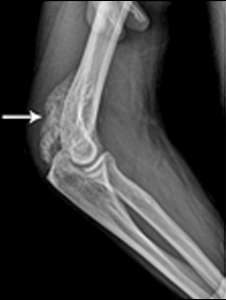

MedFriendly®


Heterotopic Ossification
Heterotopic ossification is an abnormal formation of bone in soft
tissue. The word "heterotopic" means pertaining to heterotopia,
an abnormal condition in which an organ or part of the body is
out of its normal place. The word "ossification" means the
formation and growth of bone. Thus, heterotopic ossification
means out of place bone formation. In heterotopic ossification,
the extra bone that is formed is what is out of place.
Heterotopic ossification commonly occurs in patients who have
fractured bones of the spine, skull, hip, or elbow. It can also
occur after a physical trauma (such as traumatic brain injury),
surgery, or burns. Heterotopic ossification can be a painful
condition, but it is not deadly. Heterotopic ossification is
sometimes confused with bone tumors when it is seen on x-ray
films.
Heterotopic ossification of the
elbow.
FEATURED BOOK: Miller's Review of Orthopedics
Heterotopic ossification can be treated with medication, surgery, and/or radiation (a type
of energy). Radiation is a type of energy in the form of waves or streams of particles.
Surgery for heterotopic ossification, in which the excess bone is removed, has variable
results, but usually results in improved functioning. The exception to this is in a form of
heterotopic ossification known as fibrodysplasia ossificans progressiva (FOP), or
Munchmeyer disease, in which the problem is almost certain to recur even with surgery.
"Where Medical Information is Easy to Understand"™
FOP is a form of heterotopic ossification that is inherited, severely
disabling, and results in progressive bone formation in muscles,
tendons, ligaments, and fascia. Tendons are groups of fibers that
attach muscles to a bone. A ligament is a tough band of tissue that
attaches to joint bones. A joint is a place where two bones contact
each other. Fascia is a fibrous connective tissue of the body that
can be separated from other organized structures and which covers,
supports, and separates muscles. The risk of heterotopic
ossification recurrence after surgery can be decreased (except in
cases of FOP) if the doctor prescribes indomethacin. Indomethacin
is part of a group of medications known as NSAIDS (non-steroidal
anti-inflammatories) which decreases inflammation.
Arthralgia comes from the Greek word “arthron” meaning “joint,” and the Greek word “algos” meaning
“pain. “ Put the words together and you get “joint pain.”















